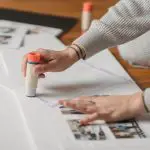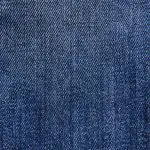When you're working with fabric glue, understanding the nuances of different fabric types is crucial for achieving the best results. You'll need to consider factors like weight, stretch, and texture when selecting your adhesive. For instance, a lightweight cotton won't bond the same way as a sturdy denim. Knowing how to choose the right glue and prepare your fabric can make all the difference. But what happens when you encounter a tricky fabric or an unexpected issue during your project? Let's explore some effective strategies to ensure your fabric creations stand the test of time.
Table of Contents
Key Takeaways
- Select the appropriate fabric glue based on fabric type: lightweight, heavy, knit, or upholstery for optimal results.
- Prepare fabric by washing, drying, ironing, and cutting for a clean, smooth surface before applying glue.
- Use a thin, even layer of glue and press fabric pieces together firmly to ensure a strong bond.
- For delicate fabrics, secure pieces with clamps or weights to prevent shifting during the drying process.
Choosing the Right Fabric Glue
When you're selecting fabric glue, consider the materials you'll be working with and the project's specific needs. Different fabrics require different adhesives, so think about whether you're using cotton, denim, or something more delicate like silk. For heavier fabrics, a strong, industrial-grade glue may be necessary, while lighter, more delicate materials might only need a washable fabric glue.
Next, determine whether you need a permanent bond or a temporary one. If you're creating something you want to last, like a quilt or a garment, opt for a permanent adhesive. If you're working on a project that needs disassembly later, such as a costume, choose a temporary fabric glue.
Also, check the drying time and flexibility of the glue. Some glues dry quickly but may become stiff, which isn't ideal for clothing. Look for flexible options that allow the fabric to move naturally.
Lastly, consider any additional features like water resistance or the ability to withstand washing. By thoughtfully evaluating these factors, you'll ensure you choose the right fabric glue that meets your project's requirements.
Preparing Your Fabric for Gluing
Before applying fabric glue, make sure your materials are clean and properly prepared to ensure the best adhesion. Start by washing your fabric to remove any dirt, oils, or residues that could interfere with the glue. If you've pre-washed your fabric, check for any lingering stains or finishes.
Once your fabric is clean, allow it to dry completely. This step is crucial, as moisture can weaken the adhesive bond. After drying, iron your fabric to remove wrinkles, ensuring it lays flat during the gluing process. Wrinkles can create gaps that prevent a solid bond.
Next, cut your fabric to the desired size and shape, using sharp scissors for clean edges. If you're working with fraying materials, consider applying a light fray check to the edges to prevent unraveling.
Lastly, always test your fabric glue on a small, inconspicuous area first. This will help you confirm compatibility and give you an idea of how the fabric will react. By taking these steps to prepare your fabric, you're setting yourself up for a successful gluing project.
Applying Fabric Glue Techniques
Applying fabric glue requires a steady hand and attention to detail to ensure an even and strong bond between your materials.
Start by positioning your fabric pieces correctly before applying any glue. Use a small brush or nozzle to apply a thin, even layer of glue to one surface. Avoid using too much glue; it can seep through the fabric and create a mess.
Once you've applied the glue, press the two surfaces together firmly but gently. Be sure to align them properly, as repositioning can be tricky once the glue starts to set. For larger projects, work in sections to maintain control and ensure even coverage.
If you're working with delicate fabrics, consider using a clamp or weight to hold the pieces together while they dry. This helps prevent shifting and ensures a strong bond.
After you've applied the glue, clean up any excess immediately with a damp cloth to prevent staining. Allow the glue to cure for the recommended time stated on the packaging, as this ensures maximum strength and durability.
Following these techniques will give you a solid foundation for your fabric projects.
Best Practices for Different Fabrics
Choosing the right approach for applying fabric glue can vary significantly depending on the type of fabric you're working with. For lightweight fabrics like chiffon or silk, use a fabric glue that's flexible and dries clear. Apply a thin layer to avoid stiffness.
For heavier fabrics, such as denim or canvas, opt for a stronger adhesive designed for heavier materials.
When working with knit fabrics, you'll want to ensure the glue maintains the stretch. Look for a fabric glue labeled as stretchable or flexible. Apply it sparingly to prevent any stiffness that could hinder movement.
If you're dealing with upholstery fabric, test the glue on a small area first. Upholstery often has a high thread count, so using too much glue can lead to unsightly lumps.
For all fabrics, ensure the surfaces are clean and dry before application. This helps the glue adhere better. Also, allow adequate drying time as specified on the glue's packaging.
Always read the instructions to understand the specific needs of the fabric and glue combination you're using. Following these best practices will help ensure your projects turn out beautifully!
Troubleshooting Common Issues
When working with fabric glue, you might run into a few common issues that can easily be fixed with the right approach.
One problem is the glue not adhering well to certain fabrics. If you notice this, try cleaning the fabric surface to remove any dust or oils before applying the glue.
Another issue could be the glue showing through the fabric once it dries. To avoid this, apply a thin layer of glue, and press the fabrics together firmly to ensure they bond properly. If you've accidentally used too much glue, you can carefully wipe away the excess before it dries.
Sometimes, fabrics may shift during the drying process. To prevent this, use clothespins or weights to hold the pieces in place while the glue sets.
If you find that your fabric is still coming apart after drying, it's possible that you need a stronger adhesive or that the glue wasn't applied evenly.
Frequently Asked Questions
Can Fabric Glue Be Washed After Application?
Yes, fabric glue can typically withstand washing after it's fully cured. However, it's best to check the specific product instructions, as some glues may not be suitable for frequent washing or high-temperature cycles.
How Long Does Fabric Glue Typically Take to Dry?
Fabric glue usually takes about 2 to 4 hours to dry completely, but it's best to wait 24 hours for a strong bond. Always check the manufacturer's instructions for specific drying times and conditions.
Is Fabric Glue Safe for Children's Clothing?
Yes, fabric glue's generally safe for children's clothing, but you should check the label for non-toxic certification. Ensure the glue's fully dry before letting your child wear the item to avoid any potential irritation.
Can I Use Fabric Glue on Leather or Vinyl?
You can use fabric glue on leather or vinyl, but make sure it's specifically designed for those materials. Test a small area first to ensure proper adhesion and avoid any damage to the surface.
What Should I Do if the Glue Leaves a Residue?
If glue leaves a residue, gently scrape it off with a plastic knife. You can also use a damp cloth with mild soap to clean the area. Always test in an inconspicuous spot first.
- Tetron Fabric for Marine Applications: Durability and Use Cases - June 18, 2025
- Tetron Fabric for Outdoor Furniture: Weather Resistance and Care - June 18, 2025
- Tetron Fabric for Wall Coverings: Style and Application Tips - June 18, 2025





